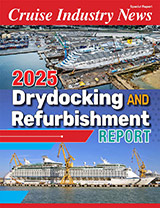Venice’s passenger port ties with Barcelona for first place among home ports in the Mediterranean
VENEZIA TERMINAL PASSEGGERI: IN 2010, IT PASSES THE TWO MILLION PASSENGER MARK
17 million euro over the next three years for infrastructure and equipment to strengthen the lagoon terminal and continue to meet the standards of an increasingly discerning clientele of international users.
The Passenger Port of Venice is a record setter. The latest estimates from Venezia Terminal Passeggeri paint a clear picture: 2010 will close with 1427 calls, 355,969 ferry passengers, 100,351 hydrofoil passengers, which added to 1,611,784 cruise passengers, for a grand total of 2,068,104 passengers who came through the lagoon terminal.
“This year we passed a milestone that seemed unthinkable only a few years ago. Having crossed the mark of two million total passengers in 2010,” enthuses the President of VTP, Sandro Trevisanato, “proves that we have worked in the right direction. The Venice terminal’s leadership in the Mediterranean is now a definite fact.”
A continuing growth trend for VTP, founded in 1997 by the Port Authority to manage and improve passenger traffic in the Port of Venice, reflects how the segment of lagoon passenger traffic is thriving. Tourism on ships in Venice is growing at a fast clip. In the last decade the number of cruise passengers has quadrupled. This places the lagoon port in a tie with Barcelona for first place for home ports of the Mediterranean, and 11th place in the international ranking of cruise ports.
PLANNED INVESTMENTS
The potentials of this growing market were grasped by Venezia Terminal Passeggeri, which adopted a major investment plan of 17 million euro over the next three years, for infrastructure and equipment to strengthen the lagoon terminal and continue to meet the standards of an increasingly discerning clientele of international users.
Specifically, work continued to build the Terminal 2 Isonzo, jointly with the Port Authority, with completion planned for the 2011-12 cruise season. Once in operation, the new Terminal, about 7000 square meters, plus a terrace above it, will offer full premium services and allow the berthing of another cruise ship for 3000 passengers.
For the conversion of old port warehouses for cruise port use, a call for bids was made in June 2010 for the remodeling of the 109/110 building. The design by architect Maurizio Paveggio adopts state-of-the-art technologies for building and plant renovation, focused on energy-saving and improving efficiency by using alternative energy sources planned for the Marittima area. The building, built in 1931 to store cotton, was previously used only for warehousing and storage, covering 14,000 sq.m. for a height of 12m. The remodeling will create an additional independent passenger station at the Tagliamento wharf to be able to more smoothly serve two ships moored at the same time in front of Terminal 107/108 and across from the new terminal. In order to fully use and optimize the space, the new terminal may also serve to host events and exhibitions. The new project’s completion time is estimated at 14 months.
Significant on the front of environmental protection and eco-sustainability are the projects for the High Voltage Shore Connection (called ‘Cold Ironing’). During the 2010 season, small columns were installed to supply electricity to the Santa Marta wharf and to berth 15 in Marittima reserved for maxi-yachts. Work is also underway to install new small columns in Riva dei Sette Martiri.
TECHNOLOGICAL INNOVATIONS
The complexity of managing a passenger port with such high numbers in terms of ships and traffic of passengers and crew, and with such a multiplicity of operational sites, prompted VTP to explore innovative solutions to improve how it manages passenger flow, reduce waiting times for ships in port and reduce energy consumption for port activities. VTP Engineering was founded to fulfill this need and became a division of VTP SpA, the result of a partnership established in 2009 with AbacoIngegneria Treviso S.r.l., an engineering firm highly respected in industrial design, consulting for project management and technical engineering services. VTP Engineering’s objective is to design and implement innovative technological solutions and patents to apply to port-related areas.
The first project, already in progress, is the MBT (Multipurpose Boarding Tower), an innovative solution for embarking and disembarking passengers, especially for those with reduced mobility, from cruise ships. It consists of a multipurpose mobile tower which uses lifts to connect the dock, the terminal and the ship, for any height of the boarding bridge, allowing multiple alternative routes for both passengers and wharf/crew personnel. The first prototype is under construction and is expected to be in operation for the 2011 season.
DEVELOPMENT ON THE DOMESTIC AND FOREIGN MARKETS
Backed by its know-how and success in the lagoon, making VTP one of the most respected global players in the industry, the company is broadening its horizons and taking on important challenges. The lagoon port is the main source of cruise tourism in the eastern Mediterranean. Its successes have a positive impact on other ports as well, such as Dubrovnik and Bari. This is the background for VTP’s entrance into the firm that has been managing the new cruise terminal in Ravenna since 2010. The corporate structure also includes Marconi Airport in Bologna, Bassani, a shipping agent and tour operator, and Royal Caribbean Ltd, the second largest cruise group in the world. It’s a strategic port for the entire Adriatic system. In 2011, 140,000 passengers are expected with calls rising from 12 to 75. This is impressive growth, considering that last year the figure was just 10,000 passengers. This is the result, first, of a growing cruise trend seeing the Mediterranean as a favorite tourist destination. Ravenna, specifically, is a destination that combines history, culture, and fine food and wine. This positive trend was bolstered by two more fundamental factors: making cruises for every period of the year, extending the tourist season from January to December, and, importantly, combining forces with Venice to establish new routes in the Adriatic. The terminal’s geographic location makes it interesting for developing tours in Emilia Romagna and Tuscany.
The implementation of new cruise routes and joint efforts with national ports form the foundation in its participation in the call bids proposals for the privatization of the Cruise Port of Catania. VTP presented a plan to manage, jointly with the local Port Authority operations and services of the cruise terminal by Mount Etna to strengthen its capacities. The bidding deadline has already passed and the results will soon be announced.
LOCAL DEVELOPMENT PROJECTS
At the regional level, VTP is focusing on two areas of interest. The first area is a plan already submitted to the competent authorities for a wharf and a terminal for the new-generation megaships. An area was chosen in the immediate mainland by Venice with a site in between the municipalities of Mira and Venice, located between the canals of Avesa and Dogaletto. The area, in addition to being less restricted environmentally, is advantageous in terms of infrastructure. The projects’ estimated cost would come to approximately 95 million euro, with estimated completion times of 14 consecutive months. This investment is very worthwhile, considering the direct economic impact of the cruise industry in the Venetian area. A 2006 study by the University Cà Foscari put its value at 180 million euro a year, adjusted for expected traffic flows for 2010 to come to over 280 million euros per year. This amount doubles if we consider indirect revenues.
The second area is a competition for a forty-year concession to build and operate the new terminal for the Autostrade del Mare at Fusina, for which VTP joined a pool of companies in the Venice Newport consortium, which won the competition.
In addition to VTP, the consortium includes Mantovani, Adria Infrastrutture, Coveco, Thetis and Nuova Fusina Ingegneria. The first part of the project pertains to two docks that can accommodate commercial and passenger ferries. The second part of the project will include two additional berths, one of which suitable for accommodating cruise ships up to 360m in length, followed by plans for 324,000 sq.m. logistics platform for storing and handling goods. When fully operational, the ferry terminal will handle 850 ferries and 110 trains per year to gradually reach 1000 ferries.
INNOVATIVE MARKETING
MADE IN VENICE: A project supporting high quality Venetian crafts
Venezia Terminal Passeggeri, as part of the international conference “The Intangible Cultural Heritage: A World Stage for Venetian Traditions”, held in its facilities last October, introduced “Made in Venice”. This is an interactive project for a Venetian tour, promoted directly by VTP to discover fine crafts (such as glass, fabric, lace, embroidery, masks, costumes, gondolas) and quality shops of the Venetian Republic. The project will result in a print and digital publication ready in March 2011 for leading cruise lines worldwide, which can be included in the excursions in their catalogs, a tour to discover authentic traditions through a special selection of high quality artisan workshops and shops that make and sell crafts. The innovative direct marketing project can be accessed by industry professionals on any digital platform. VTP has always fostered local marketing initiatives to highlight Venice and its lagoon. After the success of the first edition of Port Guide, created in 2006 with Slow Food, about food and wine tours, this is a new tool to discover the best of traditional local crafts, from Murano glass art to lace making, that charm thousands of tourists from around the world.
ADRIATIC SEA: A PRACTICAL EXAMPLE OF CO-MARKETING BY PORTS IN THE SAME CRUISE MACROAREA
Venezia Terminal Passeggeri and Ravenna Terminal Passeggeri are promoting a new edition of Adriatic Sea – A Sea of a Thousand Faces. In 2002 the project first created a single network of the major ports of the Adriatic Sea to present a unified, coordinated image to spotlight the vast, varied tourism options that this area offers to the industry. The new publishing project seeks to reinforce this network’s image through a series of initiatives and strategic choices that give it an identity on the international scene and help it compete with other industry players. The project aims to be an invitation to discover the best destinations on the Adriatic coast, through short-range cruise options, accompanied by technical details about the ports, tourist information and interesting, original ideas for excursions.
The project, which involves Ravenna and Venice as well as other ports on the Adriatic, including Dubrovnik, Koper, Opatija, Pirano/Portoros, Rab, Rijeka, Sibenik, Split, Trieste and Zadar, aims to attract the attention of the international cruise market to create strong growth in terms of passenger numbers and new calls. The publication will be presented at the cruise conference in Miami in March (2011).



